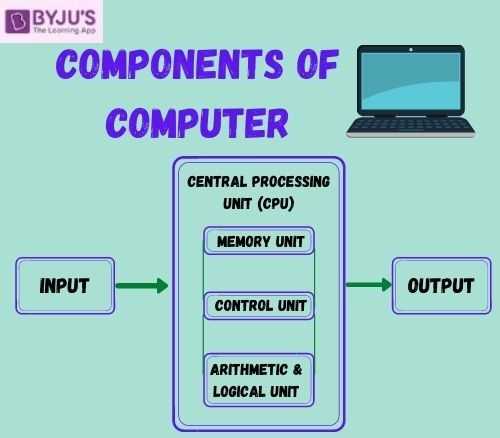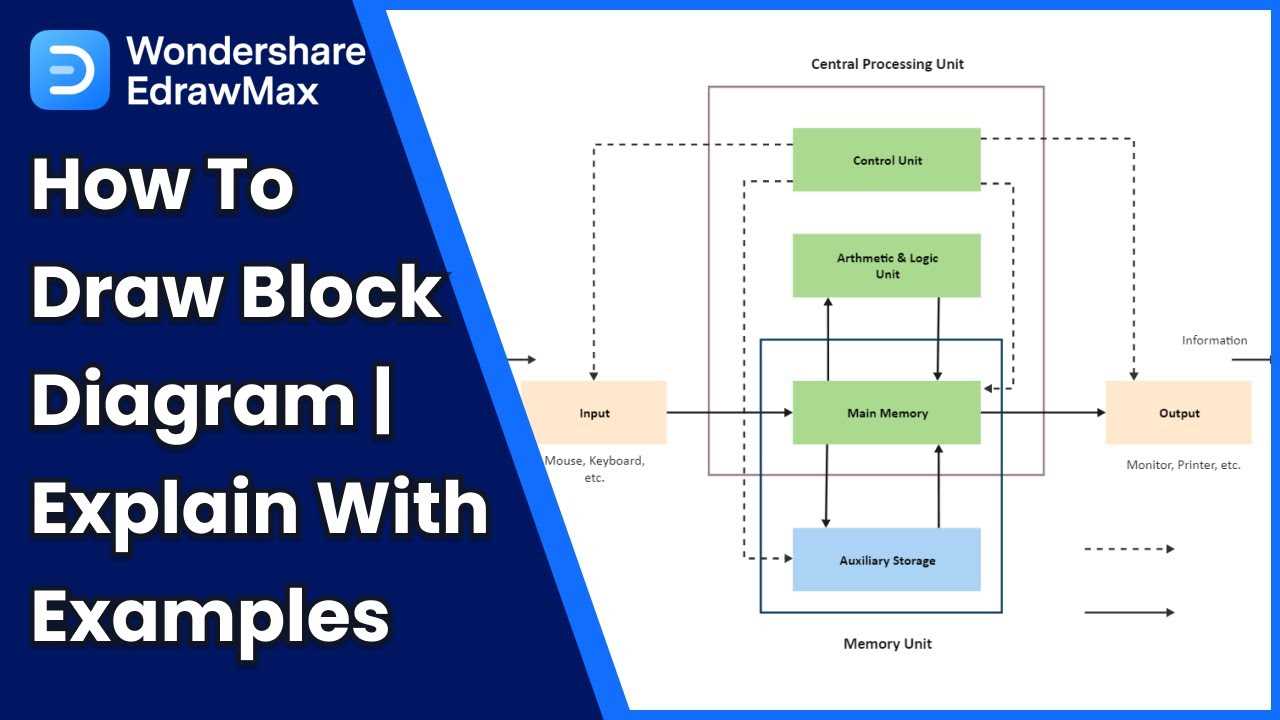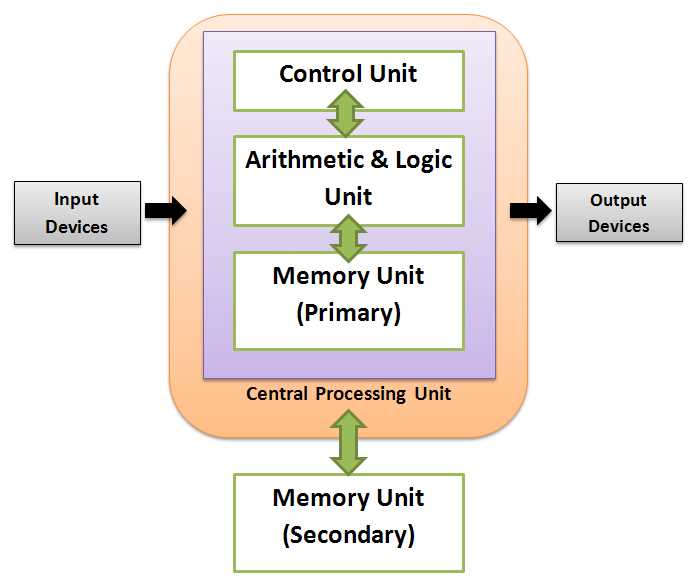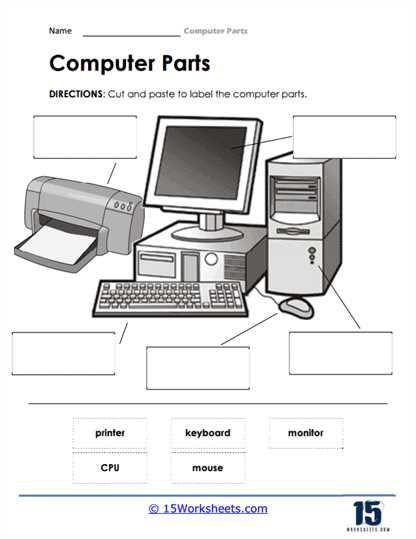Exploring the Key Components of a CPU with Diagram

The inner workings of a computing unit are crucial for its performance and efficiency. Grasping the essential elements that contribute to its functionality allows for a deeper appreciation of how modern technology operates. Each segment plays a distinct role, orchestrating complex tasks that enable seamless user experiences.
Within this framework, various units collaborate to execute instructions, manage data flow, and ensure synchronization across operations. This intricate assembly is fundamental to achieving high-speed computations and reliable processing power, which are vital in today’s digital landscape.
By exploring the specific functions of these integral components, one can gain insights into the technological marvels that underpin everything from personal devices to large-scale computing systems. Understanding their interplay not only enhances knowledge but also empowers individuals to make informed decisions regarding hardware choices and optimizations.
Understanding the CPU Structure

The central processing unit serves as the brain of a computer, executing instructions and managing operations. Its architecture plays a crucial role in determining performance and efficiency.
Key components contribute to its overall functionality:
- Control Unit: Directs operations and manages data flow.
- Arithmetic Logic Unit (ALU): Performs mathematical and logical calculations.
- Registers: Small storage locations for quick data access.
- Cache Memory: Provides fast access to frequently used information.
- Buses: Facilitate communication between components.
Understanding these elements is essential for grasping how tasks are executed and how efficiency is achieved.
Core Components of a CPU
The heart of any computing device lies in its essential elements, which work together to perform intricate tasks. These fundamental building blocks are responsible for executing instructions, managing data flow, and ensuring smooth operations within the system. Understanding these components is crucial for grasping how modern technology functions efficiently.
Arithmetic Logic Unit (ALU)
The ALU serves as the computational powerhouse, executing arithmetic and logical operations. This unit handles everything from basic calculations to complex decision-making processes, making it vital for overall performance.
Control Unit (CU)
The Control Unit orchestrates the activities of all other components, directing the flow of data and ensuring that instructions are carried out in the correct sequence. It acts as the brain’s conductor, enabling seamless communication and operation within the system.
Function of the Arithmetic Logic Unit
The Arithmetic Logic Unit (ALU) serves as a critical component in computational systems, responsible for executing various mathematical and logical operations. Its primary role is to process data and perform calculations essential for executing instructions in computing tasks.
Key Responsibilities
- Performing arithmetic operations such as addition, subtraction, multiplication, and division.
- Conducting logical operations including AND, OR, NOT, and XOR.
- Comparing values to determine relationships, such as greater than, less than, or equal to.
Operational Process
- The unit receives input data and an instruction specifying the operation to be performed.
- It processes the data according to the given instruction.
- The result is then sent to memory or another component for further use.
This functionality enables a variety of applications, from basic calculations to complex algorithmic processing, highlighting the importance of this unit in modern technology.
Role of the Control Unit Explained
The control unit plays a crucial role in the functioning of computing systems, orchestrating the operations of various components to ensure smooth execution of tasks. It acts as the brain’s conductor, directing the flow of data and instructions throughout the system. This function is essential for achieving optimal performance and efficiency in processing information.
Functionality and Operation
At its core, the control unit interprets instructions from memory and generates signals that guide other elements on how to respond. It coordinates the activities of the arithmetic logic unit, registers, and memory, ensuring that each operation is performed in the correct sequence. This synchronization is vital for executing complex computations and maintaining data integrity.
Impact on Performance
Efficiency of the control unit significantly influences overall system performance. A well-designed control unit can minimize delays and maximize throughput by optimizing instruction processing. Moreover, advancements in control unit technology have led to improvements in speed and reliability, making modern systems capable of handling increasingly demanding tasks. As such, understanding its role is essential for anyone interested in the inner workings of modern computing systems.
Cache Memory in CPU Performance
Cache memory plays a crucial role in enhancing computational speed and efficiency. By storing frequently accessed data and instructions, it minimizes the time the processor spends waiting for information from slower storage options.
The effectiveness of cache memory can be attributed to several key factors:
- Proximity to Processor: Being located closer to the core, cache memory reduces latency compared to main memory.
- Speed: It operates at much higher speeds, allowing for rapid access to critical data.
- Hierarchy: Cache memory typically consists of multiple levels (L1, L2, L3) to optimize performance at various stages of data retrieval.
These characteristics contribute significantly to overall system performance, impacting tasks such as:
- Data Processing: Quick access to essential data accelerates computational tasks.
- Multitasking: Improved efficiency allows for smoother execution of multiple applications.
- Gaming and Graphics: Faster retrieval enhances the performance of graphics-intensive applications.
In summary, cache memory is an integral component that boosts the performance of processing units by ensuring that the most crucial data is readily available, thereby reducing delays and enhancing overall efficiency.
Registers: Temporary Data Storage
Registers play a crucial role in the processing unit, serving as rapid-access locations for holding information that is currently being utilized. Their speed and proximity to the core processing elements allow for efficient data manipulation and retrieval, significantly enhancing overall performance.
Types of Registers
- General-Purpose Registers: Used for a variety of operations, these registers can store different types of data temporarily.
- Special-Purpose Registers: Designed for specific functions, such as instruction storage or status tracking, these registers streamline processing tasks.
Importance of Registers
- Enhance speed: By providing quick access to frequently used data.
- Reduce latency: Minimize the delay in data processing.
- Support multitasking: Enable efficient context switching between different processes.
Data Buses: Information Transport Mechanism

In the realm of computing, a crucial component facilitates the movement of information between various entities. This transport mechanism plays a vital role in ensuring seamless communication within a system, allowing for efficient data exchange.
These transport channels are characterized by several key features:
- Parallel Communication: Multiple bits transmitted simultaneously, enhancing speed.
- Serial Communication: Bits sent one after another, often used for longer distances.
- Bandwidth: The capacity to transfer data, impacting overall performance.
Understanding the function of these transport pathways is essential for grasping how information flows within modern technology.
- Types of Data Buses: Distinct classifications exist based on their operational methods.
- Importance in System Architecture: They are foundational for inter-component connectivity.
- Future Developments: Innovations aim to increase efficiency and reduce latency.
CPU Clock Speed and Its Importance
The speed at which a processor operates significantly influences its performance and efficiency. This metric serves as a crucial determinant in assessing the overall capability of a computing system. Understanding its implications can aid in making informed choices regarding technology investments.
Understanding Clock Speed
Clock speed refers to the frequency at which a processor executes instructions, measured in gigahertz (GHz). Higher frequencies generally allow for faster data processing, enhancing the user experience during resource-intensive tasks. However, various factors can affect actual performance, making it essential to consider other specifications alongside this metric.
Impact on Performance
While clock speed is important, it is not the sole indicator of efficiency. Other aspects, such as architecture and core count, also play significant roles. Evaluating these elements collectively provides a clearer picture of a processor’s true capabilities.
| Factor | Impact on Performance |
|---|---|
| Clock Speed | Higher speeds lead to quicker execution of tasks. |
| Core Count | More cores allow for better multitasking and parallel processing. |
| Architecture | Efficient designs optimize instruction execution and energy usage. |
How CPU Architecture Affects Efficiency
The design and structure of processing units play a crucial role in determining their overall performance and energy consumption. A well-thought-out configuration can lead to significant improvements in computational speed and resource management.
- Optimized instruction sets enhance execution speed.
- Cache memory improves data retrieval times.
- Multi-core designs allow for better multitasking capabilities.
Moreover, the way components are interconnected can impact data flow and reduce latency. Understanding these elements is essential for maximizing performance.
- Effective pipeline architecture increases throughput.
- Parallel processing can drastically enhance computational tasks.
- Energy-efficient designs contribute to lower operational costs.
In conclusion, exploring the intricacies of architectural choices reveals the ultimate potential for efficiency in modern computing systems.
Integrated Graphics vs. Dedicated GPUs
The realm of visual computing is shaped by two primary categories of processing units: integrated and dedicated solutions. Each type presents unique characteristics and performance capabilities, catering to different needs and preferences of users.
Integrated Graphics
Integrated solutions are built into the main processing unit, sharing system memory for graphical tasks. This approach offers several advantages:
- Cost-effective: No additional hardware investment is required.
- Space-saving: Ideal for compact systems or laptops.
- Energy-efficient: Consumes less power, leading to longer battery life.
However, integrated graphics often have limitations in performance, particularly for demanding applications like gaming or professional design software.
Dedicated GPUs
Dedicated units are standalone components designed exclusively for handling graphics-intensive tasks. Their strengths include:
- Superior performance: Capable of handling high-resolution graphics and complex computations.
- Enhanced features: Support for advanced technologies like ray tracing and AI enhancements.
- Upgrade potential: Can be replaced or upgraded independently of other components.
Nonetheless, they come with drawbacks such as higher costs and increased power consumption, which may not suit every user’s needs.
Power Consumption and Heat Management
Efficient energy usage and thermal regulation are critical aspects of modern computing systems. As components operate at increasingly higher speeds, the challenge of managing the heat generated becomes paramount. Addressing these issues is essential for enhancing performance and prolonging the lifespan of electronic devices.
Understanding Power Consumption
Power usage in computing elements can significantly impact overall system efficiency. Key factors include:
- Voltage levels
- Frequency of operation
- Workload intensity
Minimizing energy waste is not only beneficial for performance but also vital for reducing operational costs and environmental impact.
Heat Management Strategies
Effective thermal control is necessary to prevent overheating, which can lead to hardware failures. Common techniques include:
- Active Cooling: Utilizing fans and liquid cooling systems to dissipate heat.
- Passive Cooling: Employing heat sinks and thermal pads to manage heat without additional energy input.
- Thermal Throttling: Reducing performance during high-temperature scenarios to maintain safe operating conditions.
- Material Selection: Choosing components with better thermal conductivity and lower heat generation.
Implementing these strategies effectively ensures that systems operate within safe temperature ranges, enhancing reliability and performance.
Visual Representation of CPU Parts

This section aims to provide a clear and engaging depiction of the essential components that constitute the central processing unit, facilitating a better understanding of their roles and interactions within a computing system.
Key Elements Overview
Each crucial element works in harmony to execute instructions and manage data. Visual aids serve to illustrate these connections effectively, enhancing comprehension of their collective function.
Component Functions
| Element | Function |
|---|---|
| ALU | Performs arithmetic and logical operations. |
| Control Unit | Directs operations within the system. |
| Registers | Stores temporary data for quick access. |
| Cache | Holds frequently accessed information for faster retrieval. |